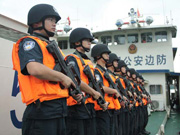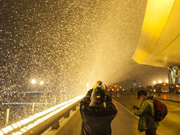Located in the northwest part of Hubei Province, Xiangyang sits in the middle reach of Han River, facing Fancheng across water. According to Commentary on the Waterways Classic, “as sitting to the south (sunny side) of Xiang River, the city gains its name as Xiangyang (In Chinese, yang refers to sun).” Xiangyang was acclaimed as “Iron-like Xiangyang” since it has been proved to be an impregnable city guarded by stout and towering city wall, easy for self-defense but extremely difficult to attack. Roughly speaking, Xiangyang resembles a square in shape, with its northern side adjacent to Han River slightly wider than southern side abut to Mountain Xian. The city wall, measuring 10.84 meters in height and 7,331 meters in perimeter, is comprised by 6,408 meters of dado brick wall, 680 meterx of rammed earth wall, 243 meters of damaged wall. The city wall was made by bricks of various sizes. The oldest existing bricks were produced in the 16th Year under the reign of Emperor Hongwu, judged from the characters imprinted on their edges. The existing city wall, which consists of wall built by bricks produced during the early years of Ming Dynasty and gate tower rebuilt in Qing Dynasty, still basically remains intact. Except of wall, Xiangyang’s city wall system still boasts many unique and existing accessories like Long Gate Barbican, Big North Gate Barbican, Small North Gate Barbican, Madam Wall Platform, turret in southeast corner, and rebuilt Zhongxuan tower. The city wall is circled by a so-called City Lake moat measuring 130 meters in width in major part and 250 meters in maximum width. As a three-room architecture with hipped-gable roof of double eaves supported by four columns, the Gate Tower over Small North Gate was built above arch-shaped door opening. The wood and brick structured gate tower features seven-purlin and elevated-grider, and was rebuilt in the 6th Year under the reign of Emperor Daoguang. Two gates are fixed under the gate arch of the gate tower, leaving a space to be filled with stone and earth to help the city resist flood, if any. The wall platform measures 13.75 meters long and 22.6 meters wide, equipped with exterior buttress wall and interior parapet wall, as well as a riding track for mounting the wall at west side.
In the 3rd Year of Taiyuan in Eastern Jin Dynasty (378), Fu Jian of the Former Qin Dynasty dispatched troops to besiege Xiangyang. Madam Han, the mother of Zhu Xu who was the general assigned to defend Xiangyang by Eastern Jin Court, led her servant girls and women in Xiangyang Prefecture to build additional city wall of more than 20 zhang (a unit for length measurement). Facing repeated failures, the invading troop had to retreat. Later, the special section of the wall was termed as Madam Wall by local people. Sprawling along the northwest corner in Xiangyang City, Madam Wall is connected to moat southwards by a cave-like passage. Many bricks imprinted with date which could be traced back to Qin Dynasty are still visible in Madam Wall.
Big North Gate Barbican measures 6 meters in height (lower than its original height due to damage), 22.8 meters in inner width and 10.75 meters in depth. It is equipped with arch-shaped door opening in east, west and south directions (since it faces Han River to the north, there is no need for it to have a door opening in south direction). Two water dams are set to its east and west door openings. Big North Gate Barbican in fact functions as a stout waterproof dam. Whenever there is food threat, the barbican can shut down its water dams for self-defense.
Long Gate Barbican is located in the northeast corner of the wall, measuring 4,000 square meters in total. Its northern wall is also absent of door opening due to facing Han River. Its southern wall was bulldozed to make way for the construction of Jiaozuo-Zhicheng Railway. At present, the barbican measures 7 meters in height, 25.5 meters in depth and 34.5 meters in width (remnant width due to damage). Its door opening is 34.4 meters. And the door opening length of its embrasured watchtower is 12 meters. The barbican can be closed as well.
There are two observatories above eastern wall, all 7 meters higher than the wall body.
 |

 Rime scenery in Mount Huangshan
Rime scenery in Mount Huangshan 'Jin' named the word of the year by cross-strait netizens
'Jin' named the word of the year by cross-strait netizens PLA elite units unveiled
PLA elite units unveiled  Chinese scientific expedition goes to build new Antarctica station
Chinese scientific expedition goes to build new Antarctica station Record of Chinese expressions in 2013
Record of Chinese expressions in 2013 Chinese naval escort fleet conducts replenishment in Indian Ocean
Chinese naval escort fleet conducts replenishment in Indian Ocean Weekly Sports Photos
Weekly Sports Photos 17th joint patrol of Mekong River to start
17th joint patrol of Mekong River to start Spring City Kunming witnesses snowfall
Spring City Kunming witnesses snowfall China's moon rover, lander photograph each other
China's moon rover, lander photograph each other Beijing tenants
Beijing tenants  China's aircraft carrier carrys out 1st docking manoeuver in Sanya
China's aircraft carrier carrys out 1st docking manoeuver in Sanya Japanese stage protest against secrecy bill
Japanese stage protest against secrecy bill
Day|Week|Month